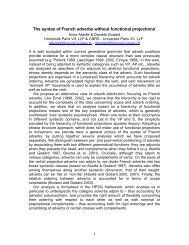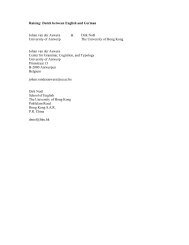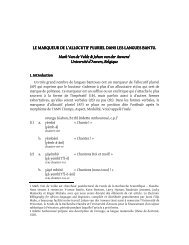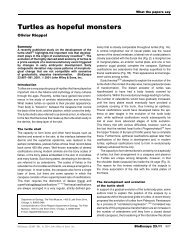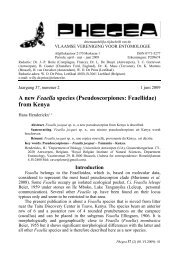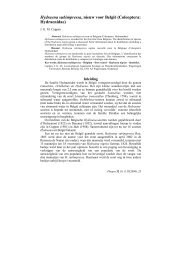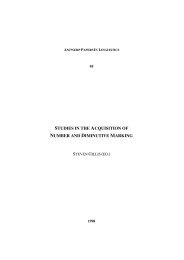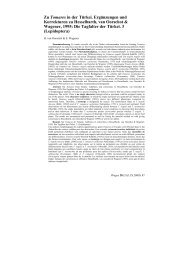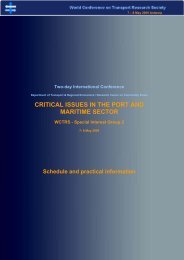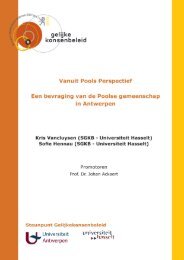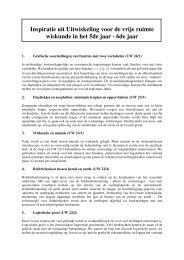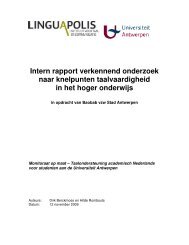Theodor2005.pdf
Theodor2005.pdf
Theodor2005.pdf
Create successful ePaper yourself
Turn your PDF publications into a flip-book with our unique Google optimized e-Paper software.
166 Theodor and Foss<br />
Table I. List of Characters Used in the Phylogenetic Analysis<br />
Dentition<br />
1. I3 similar in size to I1–2 (0); I3 larger than I1–2<br />
2. upper canines vertically oriented (0); laterally splayed (1)<br />
3. upper canine single-rooted (0); double-rooted (1)<br />
4. P1 single-rooted (0); double-rooted (1); absent (2) (modified from O’Leary, 1998) ∗<br />
5. P3 three-rooted (0); double-rooted (1) (from Zhou et al., 1995)<br />
6. P4 protocone present (0); absent (1)<br />
7. P4 paracone similar in height to M1 paracone (0); greater than twice M1 paracone height (1) (from<br />
Thewissen et al., 1994)<br />
8. P4 metacone absent (0); present (1) (from Thewissen and Domning, 1992)<br />
9. P4 entocingulum (i.e., lingual cingulum) present, partially surrounding base of protocone (0); absent<br />
or very small (1) (from Geisler (2001a,b)<br />
10. M1 parastyle absent (0); present (1) (Thewissen et al., 2001; modified from O’Leary, 1998)<br />
11. M2 metacone similar in height to paracone (0); smaller than paracone (1) (from Zhou et al., 1995)<br />
12. M2 trigon basin large (0); small (1) (from Thewissen et al., 1994)<br />
13. M2 paraconule present (0); absent (1) (O’Leary, 1998; O’Leary and Geisler, 1999)<br />
14. M2 metaconule absent (0); similar in size to paraconule (1); approaching size of protocone (2)<br />
(modified from Thewissen, 2001)<br />
15. M2 hypocone absent (0); present and small (1); present and similar in size to protocone (2) (modified<br />
from Thewissen, 2001)<br />
16. M2 centrocrista straight, lacking mesostyle (0); mesostyle forms open V (1); mesostyle forms narrow<br />
U (2); centrocrista absent with isolated mesostyle (3) (from Gentry and Hooker, 1988)<br />
17. M3 present (0); absent (1) (modified from O’Leary and Geisler, 1999)<br />
18. ectocingulae (i.e. buccal cingulum) on upper molars present (0); absent (1) (O’Leary, 1998)<br />
19. M2 lingual cusps conical (0); postprotocrista/premetaconule crista labially directed (crescentic lingual<br />
cusps) (1)<br />
20. dP3 metacone absent (0); three distinct cusps forming triangle, with single cusp anteriorly and<br />
molariform posteriorly (1); buccolingually compressed, major cusp with accessory denticles arranged<br />
mesiodistally (2)<br />
21. dP4 – premolariform (0); molariform (1)<br />
22. lower incisors conical (0); spatulate (1); peg-shaped (2); tusk-like (3); large peg with basal flare<br />
(occasionally massively spatulate) (4) (modified from Geisler (2001a,b)<br />
23. lower canines larger than incisors (0); lower canines reduced in size and incisiform (1) (modified from<br />
Geisler (2001a,b)<br />
24. lower canine cross-section ovate (0); triangular (1) (Gentry and Hooker, 1988)<br />
25. p1 present (0); absent (1); present and caniniform (2) (modified from Zhou et al., 1995)<br />
26. p3 metaconid absent (0); present (1) (Thewissen and Domning, 1992)<br />
27. p3 length ≤ m1 length (0); 120% < m1 length < 150% (1); greater than 150% of m1 length (2)<br />
(Gentry and Hooker, 1988)<br />
28. p4 metaconid absent (0); present (1) (Thewissen and Domning, 1992)<br />
29. p4 talonid with cusp (0); talonid lacking cusp (1) (Thewissen et al., 2001)<br />
30. m2 paraconid present (0); absent (1) (O’Leary and Geisler, 1999)<br />
31. m2 paracristid (and/or paraconid) directed lingually (0); anteriorly (1) (O’Leary, 1998; O’Leary and<br />
Geisler, 1999)<br />
32. m2 metaconid present (0); absent (1) (Zhou et al., 1995)<br />
33. m2 trigonid similar in height to talonid (0); twice as high (1) (modified from O’Leary, 1998)<br />
34. m2 hypoconulid present (0); absent (1) (O’Leary and Geisler, 1999)<br />
35. m2 entoconid present (0); absent (1) (Thewissen et al., 2001)<br />
36. m2 metaconid and entoconid cuspate (0); elongate, forms mesiodistal crest (1) (Thewissen, 2001)<br />
37. m2 mesial reentrant grooves absent (0); present (1) (Thewissen et al., 1994, modified from O’Leary<br />
and Geisler, 1999)<br />
38. m3 hypoconulid large, forming third lobe (0); small (1); absent (2) (Thewissen et al., 1994; O’Leary<br />
and Geisler, 1999)<br />
39. lingual cingulid on lower molars poorly defined or absent (0); continuous from mesial to distal extreme<br />
(1) (O’Leary, 1998)<br />
40. elongate shearing facets on molars absent (0); present, extending below gum line (1) (O’Leary and<br />
Geisler, 1999)



